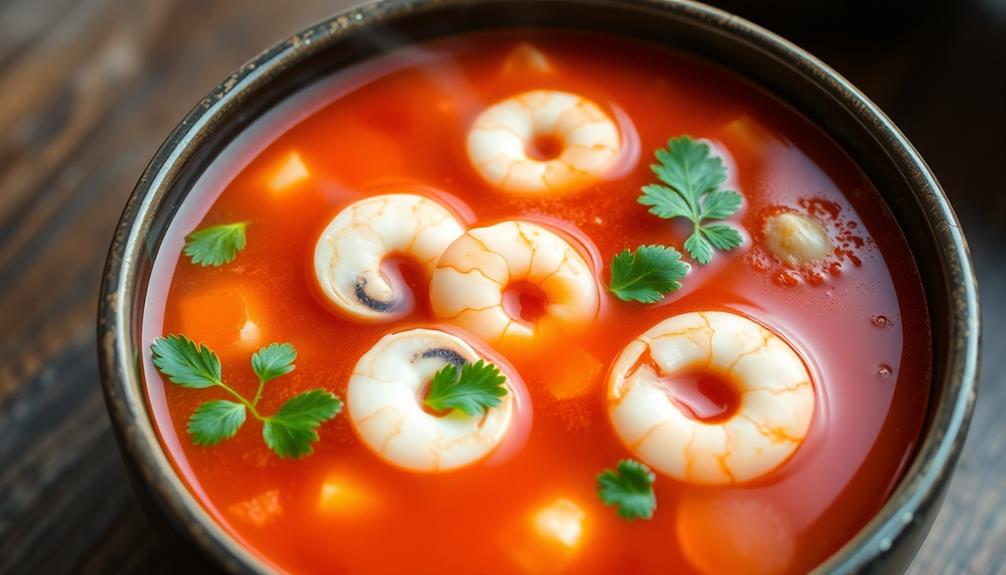Caldo Verde is Portugal's beloved green soup that'll transport you to the heart of the Minho region. It's a comforting dish brimming with tender kale and savory chorizo sausage – a cherished culinary tradition that epitomizes the country's vibrant food culture and deep connection to the land. The soup's vibrant color and hearty texture make it a symbol of Portuguese identity and pride, often enjoyed in family gatherings and celebrations. Caldo Verde's simplicity and use of local ingredients foster a sense of togetherness, and if you keep reading, you'll discover the rich history and cooking steps behind this timeless culinary treasure.
Key Takeaways
- Caldo Verde is a traditional Portuguese soup from the Minho region, known for its vibrant green color and key ingredient of kale.
- This soup symbolizes Portuguese identity and is often enjoyed in family gatherings and celebrations, fostering a sense of community.
- The recipe features humble yet flavorful ingredients, including potatoes, onions, garlic, and the optional addition of chorizo sausage.
- Caldo Verde is characterized by its simple preparation method, where the kale is finely sliced, and the potatoes are boiled and mashed to achieve a creamy texture.
- This nutritious soup is rich in vitamins, fiber, and healthy fats, making it a wholesome and comforting option for various dietary needs.
History
Although its origins are unclear, Caldo Verde is believed to have emerged as a traditional dish in the Minho region of northern Portugal. This hearty, comforting soup has been a beloved part of Portuguese culture for centuries.
The name "Caldo Verde" translates to "green broth," which refers to the key ingredient – kale. This nutrient-rich leafy green is finely shredded and simmered in a simple broth along with potatoes, onions, and garlic. The result is a vibrant, flavorful soup that's both soothing and satisfying.
Over time, Caldo Verde has become a cherished symbol of Portuguese identity and pride. Families gather to share this beloved dish, often adding their own unique touches, like the spicy cured sausage called chouriço.
Whether enjoyed on a chilly day or as part of a celebratory feast, Caldo Verde has firmly cemented its place as a timeless culinary tradition in Portugal.
Recipe
Caldo Verde is a beloved Portuguese soup that embodies the country's rustic charm and culinary heritage. This vibrant green soup is a comforting and nourishing dish, perfect for chilly days or as a starter to any meal.
At its core, Caldo Verde is a celebration of simplicity. The humble ingredients, when combined with care and skill, create a symphony of flavors that will delight your senses.
Ingredients:
- 1 lb (450g) potatoes, peeled and sliced
- 1 lb (450g) kale or collard greens, stems removed and leaves sliced into thin strips
- 1 onion, diced
- 3 cloves garlic, minced
- 4 cups (1 liter) chicken or vegetable broth
- 2 tbsp olive oil
- Salt and black pepper to taste
- Sliced chouriço (Portuguese sausage) or smoked pork sausage, for serving (optional)
Instructions:
In a large pot, heat the olive oil over medium heat. Add the onion and garlic, and sauté until softened and fragrant, about 5 minutes.
Add the sliced potatoes and broth, and bring to a boil. Reduce the heat and simmer for 15-20 minutes, or until the potatoes are tender.
Once the potatoes are cooked, add the sliced kale or collard greens to the pot. Simmer for an additional 10-15 minutes, or until the greens are tender.
Season the soup with salt and black pepper to taste.
Tips:
For a heartier meal, serve the Caldo Verde with slices of chouriço or smoked pork sausage. The spicy sausage pairs beautifully with the earthy flavors of the soup.
Additionally, you can garnish the soup with a drizzle of high-quality olive oil and a sprinkle of freshly chopped parsley for a touch of freshness.
Cooking Steps
Slice the potatoes into thin rounds and set them aside.
Next, sauté the chopped onions and garlic in a pot until they're fragrant.
Now, add the kale and let it wilt down.
Step 1. Slice Potatoes Into Thin Rounds

The potato's thin, even slices are the foundation for caldo verde's hearty texture. You'll want to grab a sharp knife and carefully slice the potatoes into rounds about 1/8 inch thick. This even thickness ensures the potatoes cook through at the same rate, creating a smooth, creamy base for the soup.
Take your time and focus on making each slice as uniform as possible. The thin, delicate potato rounds will almost melt into the broth, thickening it to a luxurious consistency.
As you work, place the sliced potatoes in a bowl of cold water to prevent them from browning. This step keeps the potatoes looking fresh and vibrant, ready to become the flavorful foundation of your caldo verde.
Once all the potatoes are sliced, drain them well and add them to the pot. They'll soak up the savory broth, softening into tender bites that complement the bold kale and spicy chorizo.
With the potatoes prepped, you're well on your way to an authentic taste of Portugal.
Step 2. Sauté Chopped Onions and Garlic
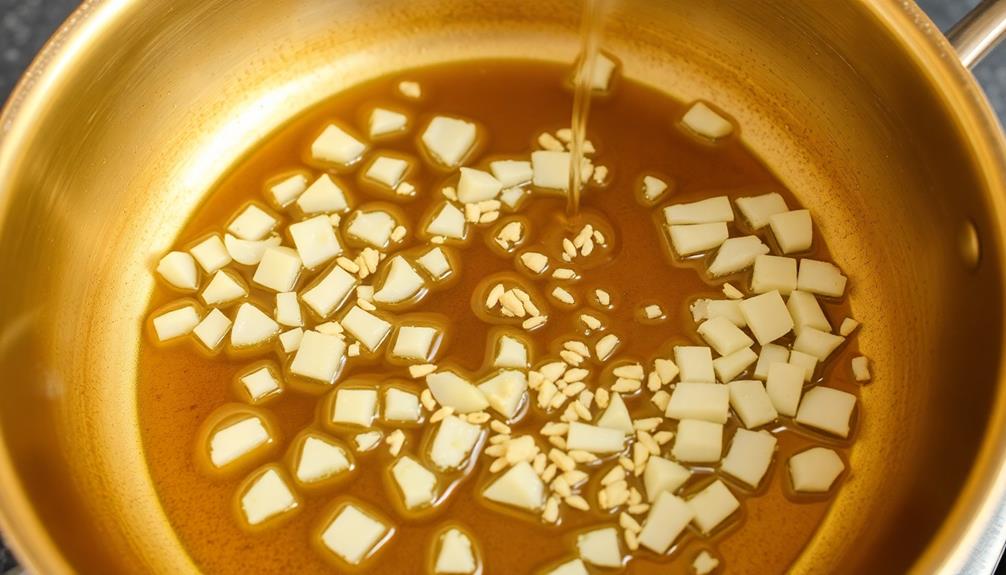
With your neatly sliced potatoes ready, it's time to sauté the onions and garlic. Grab a large skillet and heat it over medium-high heat. Add a drizzle of olive oil to the pan, and once it's shimmering, toss in the chopped onions.
Stir them around and let them sizzle for a minute or two, until they start to turn translucent and release their fragrant aroma.
Next, add the minced garlic to the pan. Be careful not to let the garlic burn – it can quickly go from perfectly toasted to bitter and acrid. Stir the garlic constantly for about 30 seconds, just until you can smell its delightful scent wafting through the kitchen.
Now that the onions and garlic are nicely sautéed, it's time to move on to the next step in creating this authentic Portuguese soup.
Keep an eye on the heat and adjust it as needed to prevent any burning or scorching. Sautéing is all about finding that perfect balance of heat and timing.
Step 3. Add the Kale
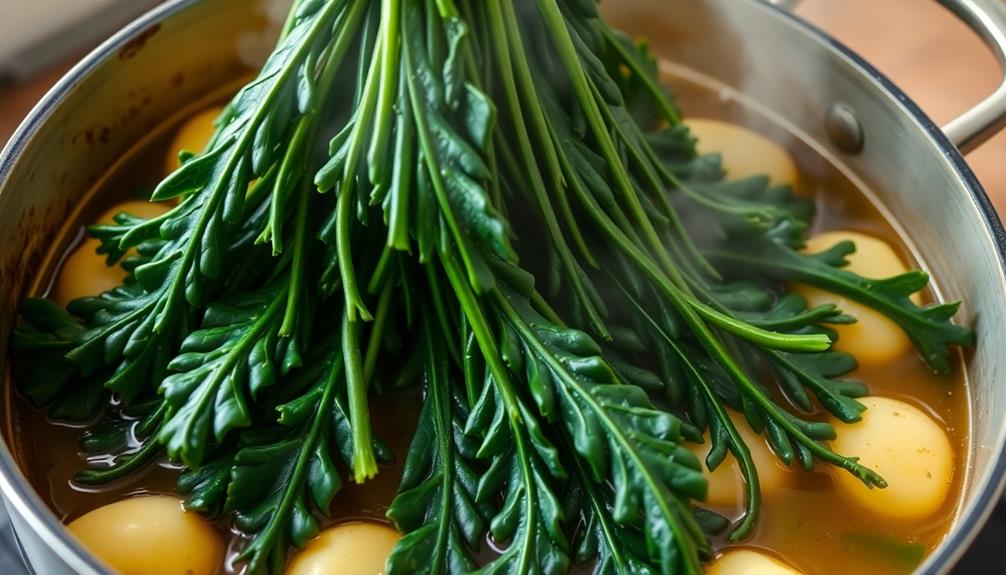
Now that the onions and garlic are nicely sautéed, it's time to add the kale.
Grab a bunch of fresh, vibrant kale and give it a good wash. Tear the leaves into bite-sized pieces, discarding any tough stems. Toss the kale into the pot with the sizzling onions and garlic.
Stir it all together, making sure the kale gets coated in the aromatic oil. As the kale cooks, it will wilt and turn a deep, rich green. Keep stirring occasionally to prevent burning.
The kale will release its natural juices, which will mingle with the onions and garlic to create a flavorful base for the soup. Let the kale cook for about 5 minutes, or until it's tender but still has a slight bite.
Now that the kale is incorporated, it's time to add the broth and start building the soup's delicious flavor.
Step 4. Add Potatoes and Broth
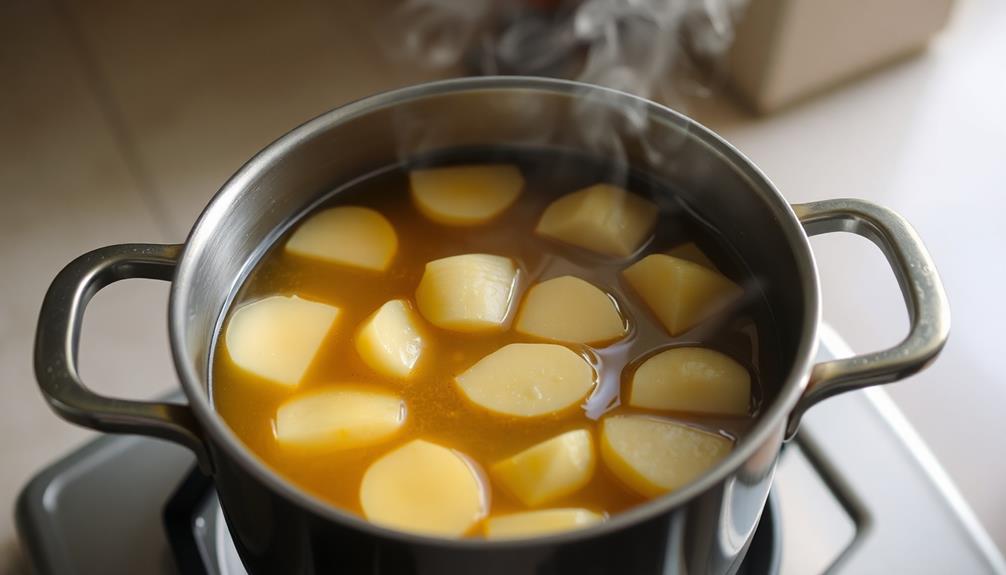
Next, grab a few potatoes and peel them. You'll want about 3 or 4 medium-sized ones.
Once they're peeled, slice them into thin, round discs. They'll cook faster that way.
Now, it's time to add the potatoes to your pot. Toss them in with the kale you added earlier.
Next, pour in the broth. You can use chicken or vegetable broth – whichever you prefer. The broth will help cook the potatoes and give your soup lots of flavor.
Bring the whole mixture to a boil, then reduce the heat and let it simmer for about 15 minutes. This will allow the potatoes to become nice and tender.
As the potatoes cook, the broth will thicken up, creating a hearty, satisfying base for your Caldo Verde.
The kale will also become nice and soft, blending perfectly with the potatoes and broth.
Soon, your kitchen will be filled with the comforting aroma of this classic Portuguese soup.
Step 5. Simmer Until Potatoes Are Tender
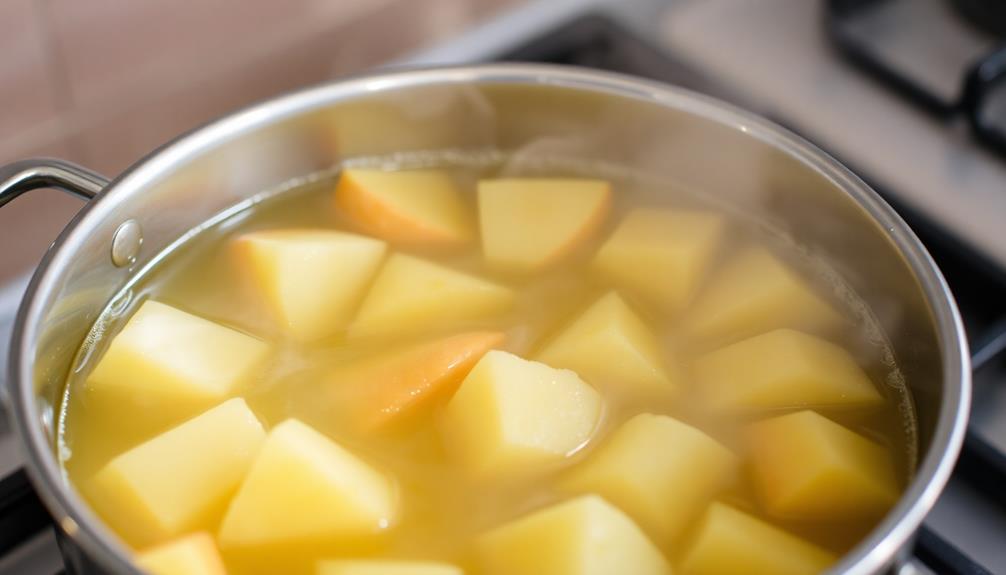
Once the potatoes are added, let the mixture simmer for about 15 minutes. This'll allow the potatoes to become nice and tender.
You'll know they're ready when you can easily pierce them with a fork. Don't forget to stir the pot occasionally so nothing sticks to the bottom.
As the soup simmers, the flavors will meld together beautifully. You'll start to smell the earthy kale and spicy chorizo come alive. It's an irresistible aroma that'll have your mouth watering!
Once the potatoes are fork-tender, the soup is ready to serve. Ladle it into bowls and get ready to dive in.
The hearty broth, soft potatoes, and flavorful greens make for a wonderfully comforting and satisfying meal. This traditional Portuguese soup is sure to warm you up from the inside out.
Enjoy every last spoonful – it's pure bliss!
Final Thoughts
Caldo Verde is a beloved Portuguese soup that encapsulates the essence of the country's culinary heritage. It's a dish that brings people together, reminding us of the simple joys of home-cooked meals and the treasures that can be found in the most humble of ingredients.
The combination of tender potatoes, vibrant kale, and the smoky, spicy chorizo creates a symphony of flavors that dance on the tongue, leaving you craving more with every spoonful.
As you savor the last bites of your Caldo Verde, you can't help but feel a sense of connection to the rich traditions of Portugal. It's a soup that transcends borders, reminding us that great food has the power to bring people together and celebrate the diversity of our world. Next, you may find yourself craving the comforting, soulful Vietnamese pho of Hanoi or perhaps the spicy and aromatic flavors of Indian curry. Each dish tells a story, and with every flavorful bite, you are transported to a different corner of the globe. It’s a beautiful reminder that we are all connected through the universal language of food.
Whether you're enjoying it on a chilly evening or a sunny afternoon, Caldo Verde is a heartwarming reminder of the comfort and joy that can be found in the most genuine and authentic of culinary experiences.
Frequently Asked Questions
What Is the Traditional Serving Size for Caldo Verde?
The traditional serving size for caldo verde is typically a hearty bowl, meant to be enjoyed as a main course. The portion should be large enough to satisfy your appetite and provide a comforting, filling meal.
Can Caldo Verde Be Made Vegetarian or Vegan?
Yes, you can absolutely make caldo verde vegetarian or vegan. Simply omit the chorizo and use vegetable broth instead of chicken stock. The kale and potatoes are the stars of this comforting soup.
How Long Does Caldo Verde Typically Take to Prepare?
Typically, preparing caldo verde takes around 30 to 45 minutes. You'll need to chop the vegetables, sauté the onions and garlic, simmer the potatoes, and add the kale or spinach just before serving for the best flavor and texture.
Is Caldo Verde Considered a Healthy or Hearty Soup?
Caldo verde is considered a healthy and hearty soup. The kale and potatoes provide essential nutrients, while the chorizo adds a savory element that makes it satisfying and filling. It's a well-balanced dish that can be enjoyed year-round.
Are There Any Regional Variations of Caldo Verde in Portugal?
Yes, there are regional variations of caldo verde across Portugal. Different regions may use different types of leafy greens, sausages, or potatoes to create their own unique takes on this traditional Portuguese soup.





